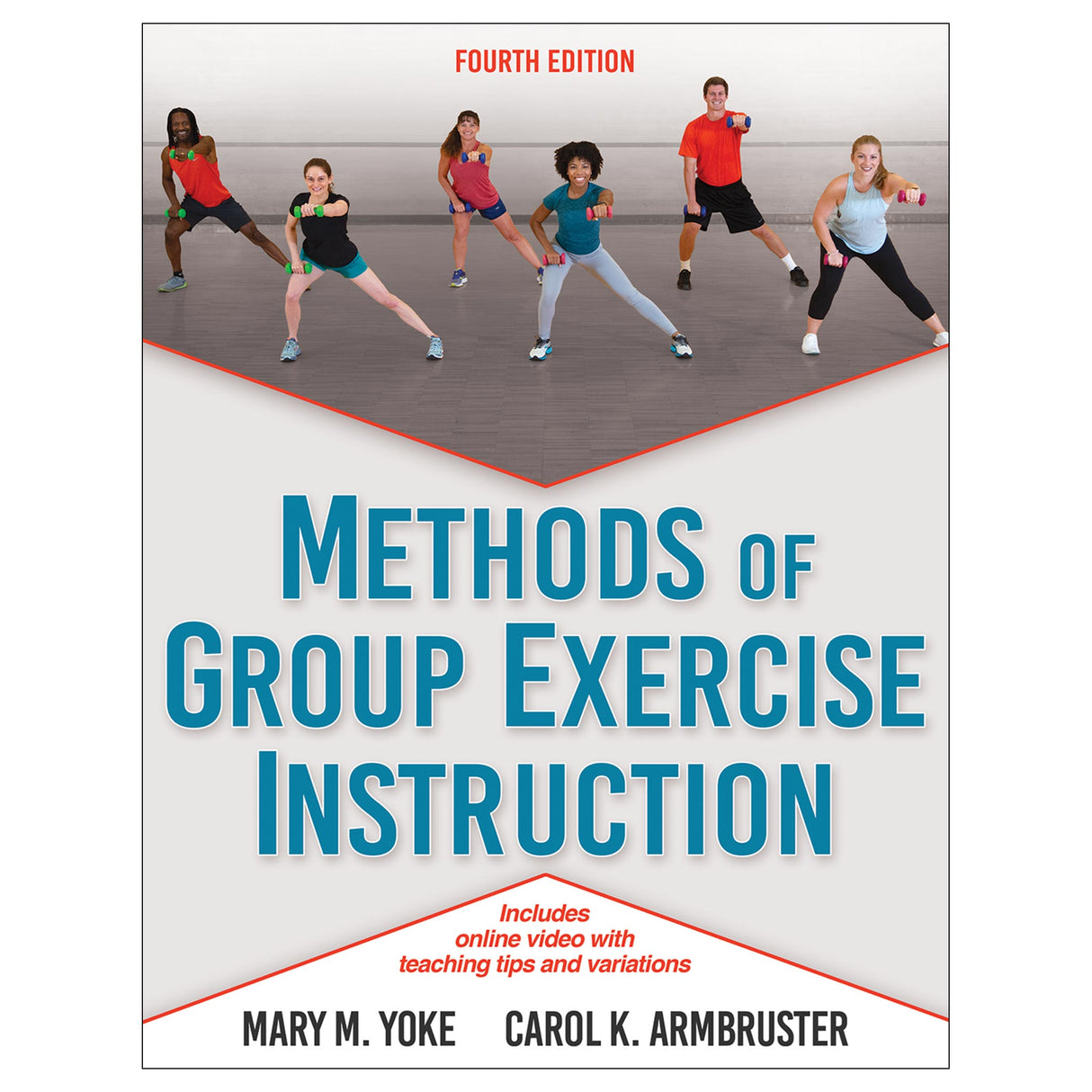Methods of Group Exercise Instruction 4th Edition epub With Online Video
Author: Mary M. Yoke, Carol K. Armbruster
$103.95 CAD
Access Duration: 10 Years
Methods of Group Exercise Instruction, Fourth Edition, goes beyond theory to help fitness instructors and managers understand the why behind class and program design, the proper way to cue participants, and the variety of modalities they can use in their teaching. Revised and reorganized based on current industry best practices, this edition includes the following:
- Over 100 minutes of online video demonstrating warm-ups, routines, drills, and 15 new class formats
- A new chapter dedicated specifically to instructing older adults
- New coverage of high-intensity interval training (HIIT)
- Two additional sample class plans for featured group exercise formats
Methods of Group Exercise Instruction, Fourth Edition, will prepare any group fitness instructor for a successful career. Students will gain a strong foundation to earn their group fitness certification, and veteran instructors will be able to refine their skills to increase their marketability and success.
Audience
Reference for fitness, physical activity, and group exercise instructors, including those preparing for certification; textbook for exercise science, fitness, physical education, kinesiology, public health, and recreation students training to be group exercise instructors.Chapter 1. Best Practices
Evolution of Group Exercise
Trends in Group Exercise
Education, Credentialing, and Certification
Creating Group Cohesion
Student-Centered Versus Teacher-Centered Instruction
Instructors as Role Models
Creating a Healthy Emotional Environment
Basic Business Practices for Group Exercise
Chapter 2. Foundational Components
Integrating Components of Health Into Class Design
Principles of Muscle Balance
Balancing Strength and Flexibility
Range of Motion for Major Joints
Progressive Functional Training Continuum
Create the Preclass Environment
Chapter 3. Coaching-Based Concepts
Motivational Strategies for Coaching-Based Group Exercise
Creating Dynamic Team Environments
Exercise Modification for Injury Prevention
Demonstrating Proper Alignment and Giving a Variety of Cues
Programming Music in a Class That Is Not Beat-Based
Chapter 4. Beat-Based Techniques
Applying Music Skills in Group Exercise
Choreography
Basic Moves
Elements of Variation
Creating Smooth Transitions
Combinations
Additional Choreography Techniques
Cueing Methods in Group Exercise
Part II. Primary Elements of Group Exercise
Chapter 5. Warm-Up, Cool-Down, and Cardiorespiratory Training
Designing a Warm-Up
Evaluating Stretching in the Warm-Up
Designing a Cool-Down
Cardiorespiratory Training Systems
Beginning Intensity
Appropriate Intensity Levels
Intensity Monitoring
Principles of Muscle Balance in Cardiorespiratory Training
Safety Issues, Good Alignment, and Technique
Importance of Participant Interaction and Enjoyment
Cool-Down After the Cardio Segment
Chapter 6. Muscular Conditioning
Recommendations and Guidelines for Muscular Conditioning
Cueing Muscular Conditioning Exercises
Demonstrating Progressions, Regressions, Modifications, and Alternatives
Safety Issues in Muscular Conditioning
Equipment for Muscle Conditioning
Chapter 7. Flexibility Training
Recommendations and Guidelines for Flexibility Training
Cueing Flexibility Exercises
Safety Issues in Flexibility Training
Flexibility Exercises
End-of-Class Flexibility Work
Chapter 8. Neuromotor and Functional Training
Neuromotor Training Principles and Recommendations
Functional Training Principles
Safety Issues in Balance and Functional Training
Equipment for Balance and Functional Training
Teaching a Balance Class
Teaching a Functional Training Class
Chapter 9. Teaching Older Adults
Modalities in Group Exercise for Older Adults
Understanding Aspects of Aging Pertinent to Group Exercise
Guidelines and Special Considerations
Facilitating Social Connections in Group Exercise for Older Adults
Exercise Modifications for Deconditioned Older Adults
Teaching a Chair-Based Class for Older Adults
Part III. Group Exercise Modalities
Chapter 10. Kickboxing
Creating a Warm-Up
Technique and Safety Issues
Basic Moves
Combinations and Choreography Techniques
Other Kickboxing Formats
Chapter 11. Step Training
Creating a Warm-Up
Technique and Safety Issues
Basic Moves and Step Patterns
Basic Combinations and Choreography Techniques
Training Systems
Chapter 12. Stationary Indoor Cycling
Positioning, Alignment, and Safety
Creating a Warm-Up
Basic Moves
Formatting Indoor Cycling Classes
Intensity Monitoring
Cueing and Coaching Techniques
Chapter 13. Boot Camp and HIIT
Creating a Warm-Up
Equipment and Setup
Planning Safe, Effective Movements
Basic Moves
Chapter 14. Water Exercise
Benefits of Water Exercise
Properties of Water and Newton’s Laws of Motion
Creating a Warm-Up
Formatting Water Fitness Classes
Training Systems
Water Exercise Equipment
Chapter 15. Yoga
Philosophy of Yoga
Breathwork in Yoga
Beginning a Yoga Class
Verbal Cues and Music
Technique and Safety Issues
Equipment and Class Setting
Chapter 16. Pilates
The Pilates Method: Basic Principles
Creating a Warm-Up
Cueing in Pilates
Technique and Safety Issues
Ending a Pilates Class
Chapter 17. Other Modalities
Creating a Client-Centered Group Exercise Class
Group Exercise for Niche Markets
Lifestyle-Based Physical Activity Classes
Dance-Based Classes
Equipment-Based Cardiorespiratory and Strength Training
Mind–Body Classes
Fusion Classes
Ethical Practice Guidelines for Group Fitness Instructors
Appendix A. Group Exercise Class Evaluation Form
Appendix B. PAR-Q+
Appendix C. Sample Workout Plans
Appendix D. Joint Action Tables
Appendix E. ROM Tables
Positioning, alignment,and safety in group cycling classes
Trends in group exercise
Instructor guide. Contains a sample syllabus, course outline, activity suggestions, and list of accompanying videos for each chapter.
Test package. Includes true-or-false, multiple-choice, and short-answer questions.
Presentation package plus image bank. Includes PowerPoint slides of text, artwork, and tables from the book that can be used for class discussion and presentation. The slides in the presentation package can be used directly within PowerPoint or printed to make transparencies or handouts for distribution to students. Instructors can easily add, modify, and rearrange the order of the slides.
The companion image bank includes most of the figures, content photos, and tables from the text, sorted by chapter. These can be used in developing a customized presentation based on specific course requirements.
Online video. Includes over 100 minutes of video, including teaching demonstrations, cueing techniques, warm-up and cool-down, progressions and modifications, and basic moves for a variety of exercise modalities.





